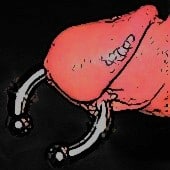Genital Piercings
Female Gential Piercings
Labia: This more common female genital piercing can be placed either through the labia minora or the labia majora (inner and outer labia). As with all genital piercings, this piercing may provide additional stimulation during intercourse.
Clitoral Hood: A piercing that passes through the clitoral hood. The two main types of hood piercings, the vertical clitoral hood piercing and the horizontal clitoral hood piercing, are differentiated by the direction the piercing is oriented in the skin above the clitoris. Neither piercing penetrates the clitoris itself.
Fourchette: The fourchette is a piercing of the small pocket of tissue located at the very bottom of the vagina where the two inner labia join.
Triangle: This piercing passes through the base of the clitoral hood tissue where it meets the inner labia and under the clitoris. The name triangle comes from from the tissue where the labia meet the clitoral hood, which looks like a triangle when pinched.
Clitoris: A piercing through the clitoris itself, this relatively uncommon piercing is often confused with the more common clitoral hood piercing and requires a large enough clitoris to make the piercing stable. Depending on the anatomy of the individual, they can be oriented either vertically or horizontally. Like piercings through the glans in a male, this piercing can be extremely sexually stimulating.


Male Gential Piercings
Prince Albert (PA): The most common form of male genital piercing, the PA piercing penetrates from the outside of the frenulum (the small tissue fold under the base of the glans) into the urethra, with the jewelry terminating outside the urethral exit of the glans. A reverse Prince Albertenters through the urethra and exits through a hole pierced in the top of the glans.
Frenum: This piercing is located on the underside of the penis passing through the frenulum perpendicular to the shaft. Multiple frenum piercings in a series are known as a ladder, Jacob’s ladderor frenum ladder.
Lorum: A lorum is placed horizontally on the underside of the penis at its base, where the penis meets the scrotum. The word lorum is a portmanteau of “low” and “frenum.”
Foreskin: Any piercing that passes through the foreskin of an uncircumcised male.
Scrotum (Hafada): Hafada piercings are surface piercings of the scrotum. Multiple hafada piercings are common as an extension of a frenum ladder. Piercings that actually pass through the scrotum, front-to-back or side-to-side, are known as transscrotal piercings.
Guiche: A piercing of the perineum, or surface tissue between the anus and the genitals. More common in men than in women, a guiche normally runs perpendicular to the direction of the penis, although lateral piercings are possible. A series of perineum piercings in parallel to the direction of the penis is called a guiche ladder.
Ampallang: An ampallang piercing penetrates the penis horizontally, most often through the head of the penis or glans. A variation on the ampallang penetrates the shaft horizontally at any point along its length. This piercing may or may not pass through the urethra as it transits the penile shaft.
Apadravya: As with an ampallang, an apadravya piercing penetrates the glans of the penis. However, while the ampallang is a horizontal piercing, an apadravya penetrates vertically through the glans from the top to the bottom at a slightly forward angle. Apadravya piercings are almost always centrally placed and pass through the urethra and, even when not centered and deliberately offset, still usually pass through the urethra.
Magic Cross: The magic cross is a combination of piercings, consisting of both an ampallang and an apadravya. These two piercings together form a cross through the glans of the penis.
Dydoes: A dydoe piercing passes through the ridge of the glans of the penis. Single dydoes are often placed on the top of the penis. If a pair, placement is at the “ten and two” positions on either side. Also possible are ‘king’s crowns’ where multiple dydoes are placed around the head of the penis.
Dolphin: A dolphin piercing is where a Prince Albert piercing is attached to another, deeper Prince Albert. This piercing is most commonly done using a curved barbell, giving the appearance of the jewelry diving through the surface of the skin, hence the name
